Physical and Numerical Simulations for Predicting Distribution of Microstructural Features during Thermomechanical Processing of Steels
Abstract
:1. Introduction
2. Model
3. Experiment
3.1. Material, Methodology and Parameters of the Tests
3.2. Dislocation Density
3.3. Histograms of Grain Size after Preheating (Prior to Deformation)
3.4. Grain Size after Hot Deformation (Dynamic Recrystallisation)
3.5. Grain Size during Interpass Times (Metadynamic and Static Recrystallisation)
4. Identification and Validation of the Model
5. Model Validation
6. Discussion of Results
7. Case Study
8. Conclusions
- The objective function in the inverse analysis was formulated as a distance between the measured and the calculated histograms. It was shown that using the Bhattacharyya metric as a measure of this distance was a very efficient approach. The results confirmed the good accuracy and reliability of the inverse stochastic approach. The predictions of the model with optimal coefficients agreed with the measurements. The Bhattacharyya metric was below 0.2 for the experiments used in the identification and below 0.33 for the experiments used in the validation, which is a reasonable accuracy when steel microstructures are compared.
- In the hot deformation experiments, better accuracy was obtained for the tests at higher temperatures and lower strain rates (e.g., T1–T4) in which dynamic recrystallisation dominated. In the static recrystallisation experiments, better accuracy was obtained for the tests with larger strain (T28–T30) in which recrystallisation was faster.
- It was observed that the accuracy of the model identification was directly dependent on the quality of the etching of austenite grain boundaries. Since, typically, not all boundaries were clearly etched, a manual reconstruction of the missing boundaries segments needed to be done, which could have resulted in significant errors.
- The lower accuracy of the developed model for low strains could be connected with a significant overlapping of the recovery and recrystallisation processes, which needs the improved methodology of the separation of their effect in plastometric studies. This will be the subject for future activities.
- The model with optimal coefficients was applied to the simulation of the three-stage hot-forging process. The predictions of the model were in qualitative agreement with the authors’ knowledge regarding hot forging, and the extensive predictive capabilities of the model were confirmed. Dislocation density (when the recrystallisation of austenite is not completed) and grain size at the beginning of phase transformation have a strong influence on the kinetics of these transformations. Thus, calculated distributions of the microstructural features can be used as a starting point for stochastic modelling of the phase transformation and prediction of histograms of phase composition in the final product. This problem will be the scope of the authors’ future research.
Author Contributions
Funding
Informed Consent Statement
Conflicts of Interest
References
- Kuziak, R.; Kawalla, R.; Waengler, S. Advanced high strength steels for automotive industry. Arch. Civ. Mech. Eng. 2008, 8, 103–117. [Google Scholar] [CrossRef]
- Wu, X.; Zhu, Y. Heterogeneous materials: A new class of materials with unprecedented mechanical properties. Mater. Res. Lett. 2017, 5, 527–532. [Google Scholar] [CrossRef]
- Chang, Y.; Haase, C.; Szeliga, D.; Madej, L.; Hangen, U.; Pietrzyk, M.; Bleck, W. Compositional heterogeneity in multiphase steels: Characterization and influence on local properties. Mater. Sci. Eng. A 2021, 827, 142078. [Google Scholar] [CrossRef]
- Motaman, S.A.H.; Roters, F.; Haase, C. Anisotropic polycrystal plasticity due to microstructural heterogeneity: A multi-scale experimental and numerical study on additively manufactured metallic materials. Acta Mater. 2020, 185, 340–369. [Google Scholar] [CrossRef]
- Motaman, S.A.H.; Haase, C. The microstructural effects on the mechanical response of polycrystals: A comparative experimental-numerical study on conventionally and additively manufactured metallic materials. Int. J. Plast. 2021, 140, 102941. [Google Scholar] [CrossRef]
- Chang, Y.; Lin, M.; Hangen, U.; Richter, S.; Haase, C.; Bleck, W. Revealing the relation between microstructural heterogeneities and local mechanical properties of complex-phase steel by correlative electron microscopy and nanoindentation characterization. Mater. Des. 2021, 203, 109620. [Google Scholar] [CrossRef]
- Wang, L.; Li, B.; Shi, Y.; Huang, G.; Song, W.; Li, S. Optimizing mechanical properties of gradient-structured low-carbon steel by manipulating grain size distribution. Mater. Sci. Eng. A 2019, 743, 309–313. [Google Scholar] [CrossRef]
- Shao, C.W.; Zhang, P.; Zhu, Y.K.; Zhang, Z.J.; Tian, Y.Z.; Zhang, Z.F. Simultaneous improvement of strength and plasticity: Additional work-hardening from gradient microstructure. Acta Mater. 2018, 145, 413–428. [Google Scholar] [CrossRef]
- Szeliga, D.; Chang, Y.; Bleck, W.; Pietrzyk, M. Evaluation of using distribution functions for mean field modelling of multiphase steels. Proc. Manuf. 2019, 27, 72–77. [Google Scholar] [CrossRef]
- Hassan, S.F.; Al-Wadei, H. Heterogeneous microstructure of low-carbon microalloyed steel and mechanical properties. J. Mater. Eng. Perform. 2020, 29, 7045–7051. [Google Scholar] [CrossRef]
- Heibel, S.; Dettinger, T.; Nester, W.; Clausmeyer, T.; Tekkaya, A.E. Damage mechanisms and mechanical properties of high-strength multi-phase steels. Materials 2018, 11, 761. [Google Scholar] [CrossRef] [PubMed] [Green Version]
- Li, S.; Vajragupta, N.; Biswas, A.; Tang, W.; Wang, H.; Kostka, A.; Yang, X.; Hartmaier, A. Effect of microstructure heterogeneity on the mechanical properties of friction stir welded reduced activation ferritic/martensitic steel. Scr. Mater. 2022, 207, 114306. [Google Scholar] [CrossRef]
- Ding, R.; Yao, Y.; Sun, B.; Liu, G.; He, J.; Li, T.; Wan, X.; Dai, Z.; Ponge, D.; Raabe, D.; et al. Chemical boundary engineering: A new route toward lean, ultrastrong yet ductile steels. Sci. Adv. 2020, 6, eaay1430. [Google Scholar] [CrossRef] [PubMed] [Green Version]
- Pietrzyk, M.; Czyżewska, N.; Klimczak, K.; Kusiak, J.; Morkisz, P.; Oprocha, P.; Przybyłowicz, P.; Rauch, Ł.; Szeliga, D. Stochastic approach to modelling microstructure evolution and properties of metals subjected to thermomechanical processing. NCN project no. 2017/25/B/ST8/01823, 2018-2021.
- Klimczak, K.; Oprocha, P.; Kusiak, J.; Szeliga, D.; Morkisz, P.; Przybyłowicz, P.; Czyżewska, N.; Pietrzyk, M. Inverse problem in stochastic approach to modelling of microstructural parameters in metallic materials during processing. Math. Probl. Eng. 2022. in review. [Google Scholar]
- Szeliga, D.; Czyżewska, N.; Klimczak, K.; Kusiak, J.; Kuziak, R.; Morkisz, P.; Oprocha, P.; Poloczek, Ł.; Pietrzyk, M.; Przybyłowicz, P. Stochastic through process model describing evolution of microstructural parameters during multi-step hot forming processes. Arch. Civ. Mech. Eng. 2022. in review. [Google Scholar]
- Gavrus, A.; Massoni, E.; Chenot, J.L. An inverse analysis using a finite element model for identification of rheological parameters. J. Mater. Proc. Technol. 1996, 60, 447–454. [Google Scholar] [CrossRef]
- Forestier, R.; Massoni, E.; Chastel, Y. Estimation of constitutive parameters using an inverse method coupled to a 3D finite element software. J. Mater. Proc. Technol. 2002, 125, 594–601. [Google Scholar] [CrossRef]
- Szeliga, D.; Gawąd, J.; Pietrzyk, M. Inverse analysis for identification of rheological and friction models in metal forming. Comput. Methods Appl. Mech. Eng. 2006, 195, 6778–6798. [Google Scholar] [CrossRef]
- Pietrzyk, M.; Madej, Ł.; Rauch, Ł.; Szeliga, D. Computational Materials Engineering: Achieving High Accuracy and Efficiency in Metals Processing Simulations; Butterworth-Heinemann: Oxford, UK; Elsevier: Amsterdam, The Netherlands, 2015. [Google Scholar]
- Szeliga, D.; Czyżewska, N.; Klimczak, K.; Kusiak, J.; Kuziak, R.; Morkisz, P.; Oprocha, P.; Pidvysotsk’yy, V.; Pietrzyk, M.; Przybyłowicz, P. Identification and validation of the stochastic model describing evolution of microstructural parameters during hot forming of metallic materials. Int. J. Mater. Form. 2022. in review. [Google Scholar]
- Soize, C.; Desceliers, C.; Guilleminot, J.; Le, T.-T.; Nguyen, M.-T.; Perrin, G.; Allain, H.; Gharbi, J.-M.; Duhamel, D.; Funfschilling, C. Stochastic representations and statistical inverse identification for uncertainty quantification in computational mechanics. In Proceedings of the 1st ECCOMAS Thematic International Conference on Uncertainty Quantification in Computational Sciences and Engineering, Athens, Greece, 21–23 June 2021; pp. 1–26. [Google Scholar]
- Ekwaro-Osire, S.; Dhorje, M.; Khandaker, M. Accounting for uncertainty in the inverse problem. In Proceedings of the XIth International Congress and Exposition, Orlando, FL, USA, 2–5 June 2008. [Google Scholar]
- Mecking, H.; Kocks, U.F. Kinetics of flow and strain-hardening. Acta Metall. 1981, 29, 1865–1875. [Google Scholar] [CrossRef]
- Estrin, Y.; Mecking, H. A unified phenomenological description of work hardening and creep based on one-parameter models. Acta Metall. 1984, 32, 57–70. [Google Scholar] [CrossRef]
- Sandstrom, R.; Lagneborg, R. A model for hot working occurring by recrystallization. Acta Metall. 1975, 23, 387–398. [Google Scholar] [CrossRef]
- Kaonda, M.K.M. Prediction of the Recrystallised Grain Size Distribution after Deformation for the Nb Free and Model Steel. Ph.D. Thesis, University of Birmingham, Birmingham, UK, 2017. [Google Scholar]
- Wang, J.; Kang, Y.; Yang, C.; Wang, Y. Effect of heating temperature on the grain size and titanium solid-solution of titanium microalloyed steels. Mater. Sci. Appl. 2019, 10, 558–567. [Google Scholar] [CrossRef] [Green Version]
- Sellars, C.M. Physical metallurgy of hot working. In Hot Working and Forming Processes; Sellars, C.M., Davies, G.J., Eds.; The Metals Society: London, UK, 1979; pp. 3–15. [Google Scholar]
- Somani, M.C.; Porter, D.A.; Karjalainen, L.P.; Kantanen, P.K.; Kömi, J.I.; Misra, D.K. Static recrystallization characteristics and kinetics of high-silicon steels for direct quenching and partitioning. Int. J. Mater. Res. 2019, 110, 183–193. [Google Scholar] [CrossRef] [Green Version]
- Kang, J.-H.; Kim, S.-J. Critical Assessment 33: Dislocation density-based constitutive modelling for steels with austenite. Mater. Sci. Technol. 2019, 35, 1128–1132. [Google Scholar] [CrossRef]
- Fukuhar, M.; Sanpei, A. Elastic steels moduli and internal friction as a function of temperature. ISIJ Int. 1993, 33, 508–512. [Google Scholar] [CrossRef]
- Outinen, J.; Mäkeläinen, P. Mechanical properties of structural steel at elevated temperatures and after cooling down. In Proceedings of the 2nd International Workshop Structures in Fire, Christchurch, New Zealand, 18–19 March 2002; pp. 273–298. [Google Scholar]
- Maraveas, C.; Fasoulakis, Z.C.; Tsavdaridis, K.D. Mechanical properties of high and very high steel at elevated temperatures and after cooling down. Fire Sci. Rev. 2017, 6, 1–13. [Google Scholar]
- Bhattacharyya, A. On a measure of divergence between two multinomial populations. Indian J. Stat. 1946, 7, 401–406. [Google Scholar] [CrossRef] [Green Version]
- Poloczek, Ł.; Rauch, Ł.; Wilkus, M.; Bachniak, D.; Zalecki, W.; Rozmus, R.; Kuziak, R.; Pietrzyk, M. Physical and numerical simulations of closed die hot forging and heat treatment of forged parts. Materials 2021, 14, 15. [Google Scholar] [CrossRef]
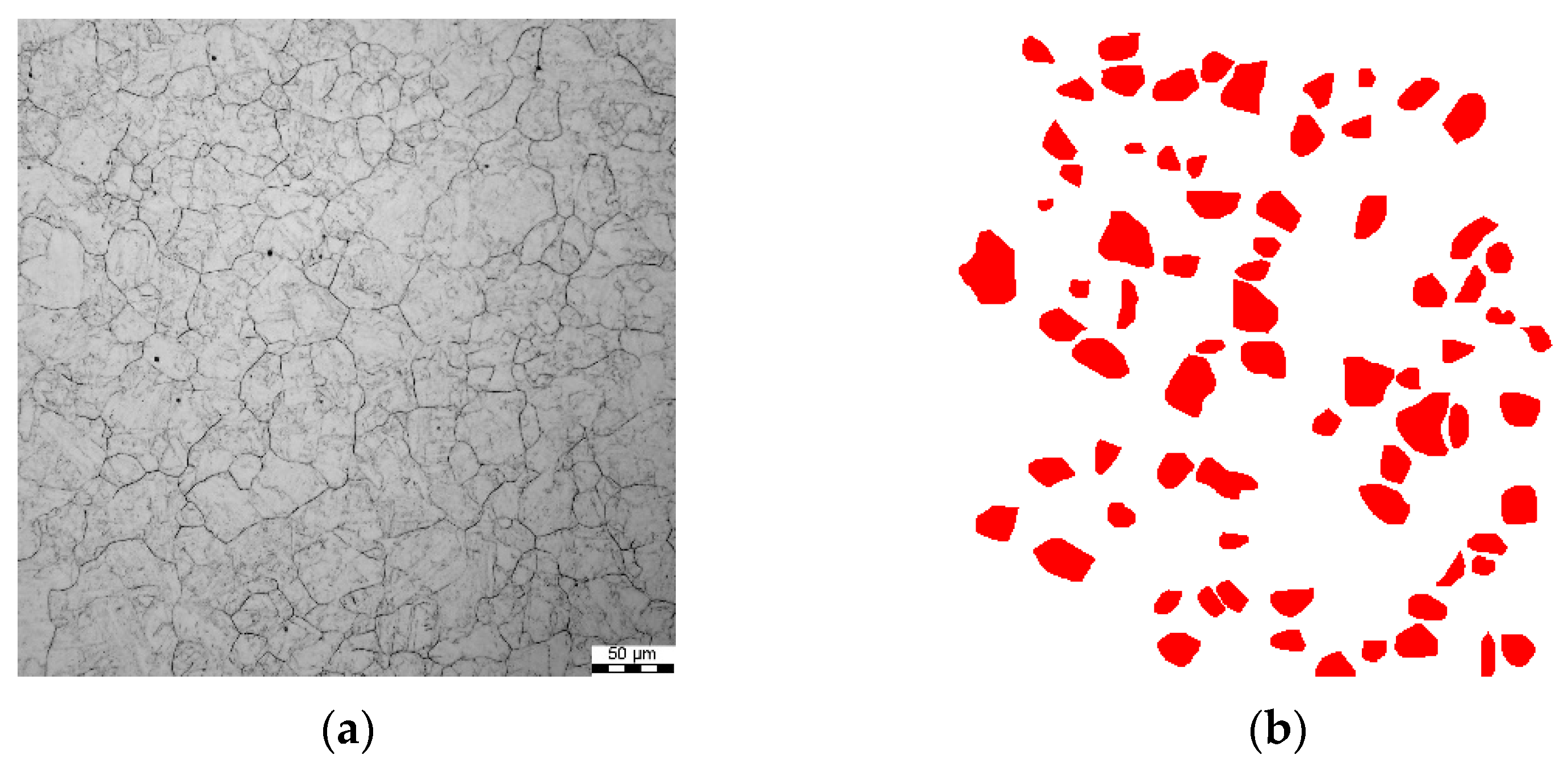



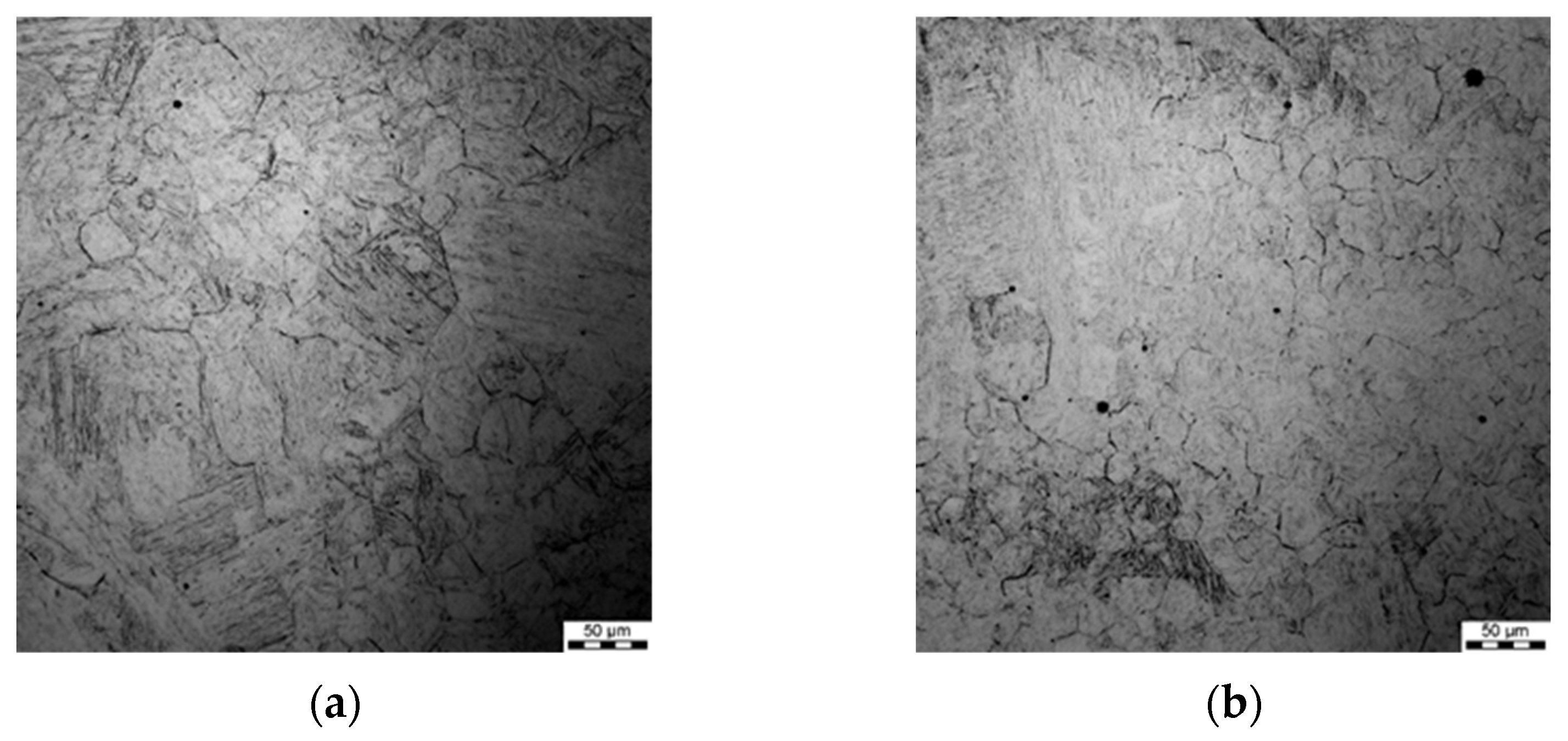
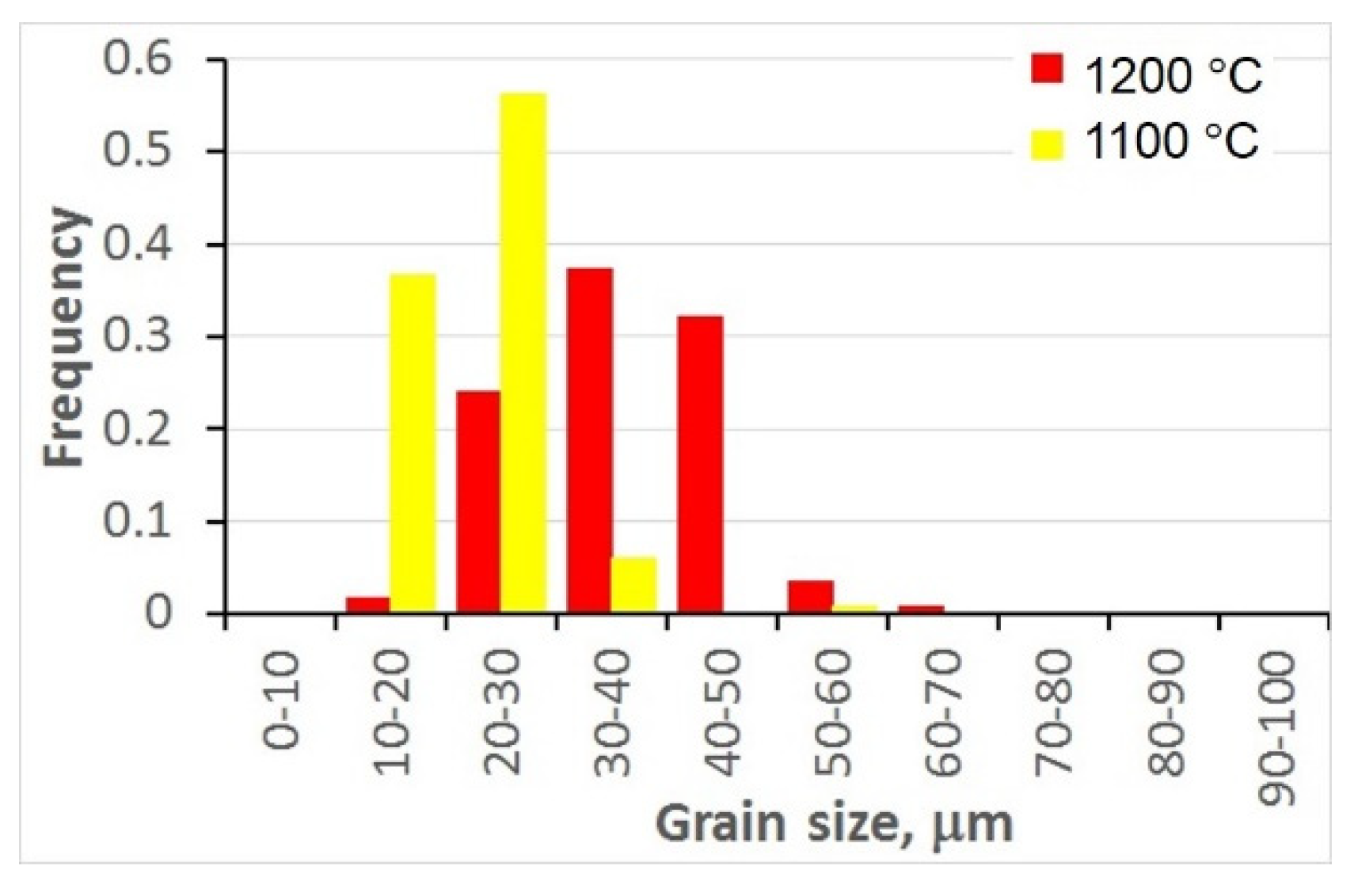








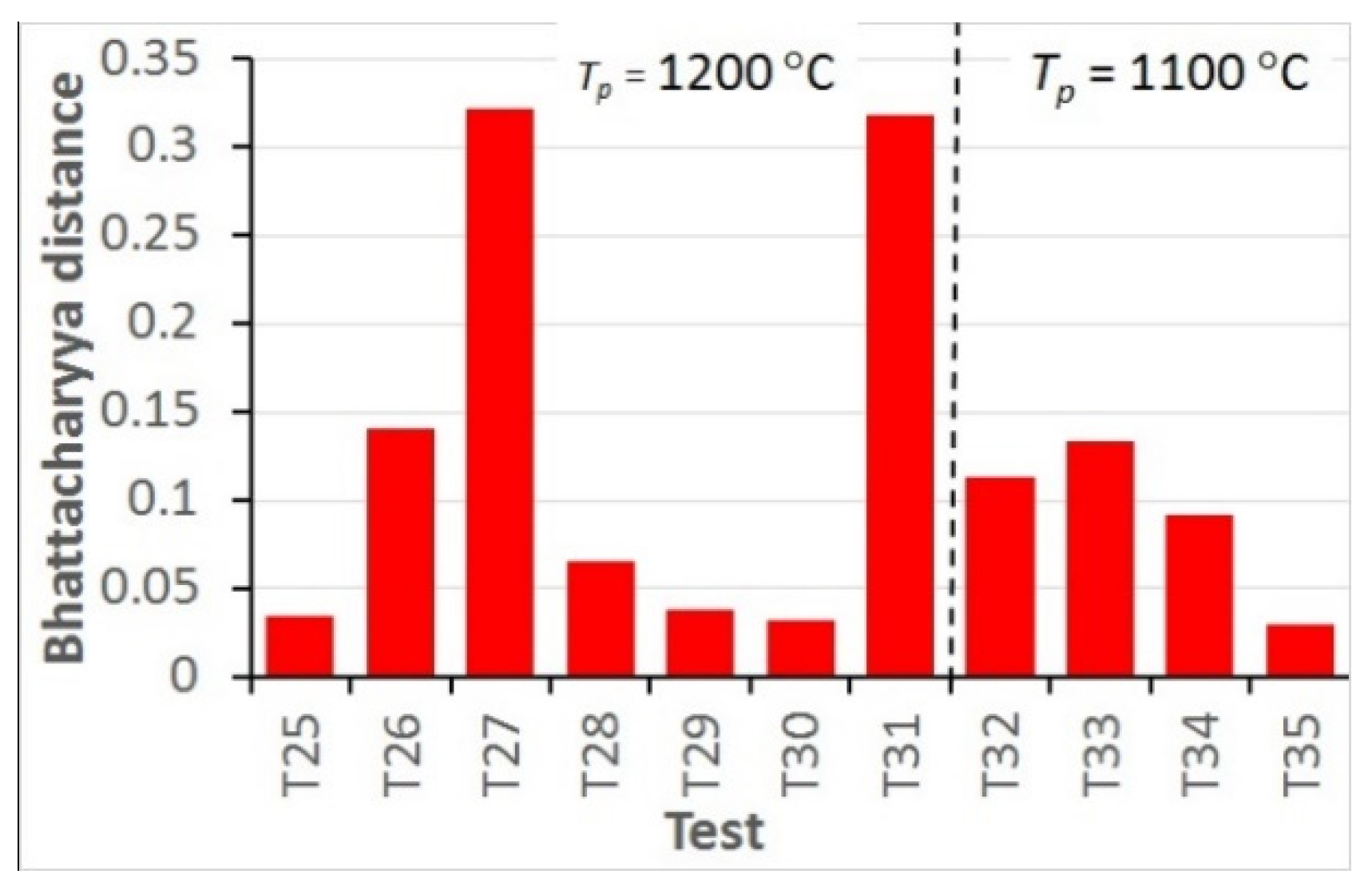

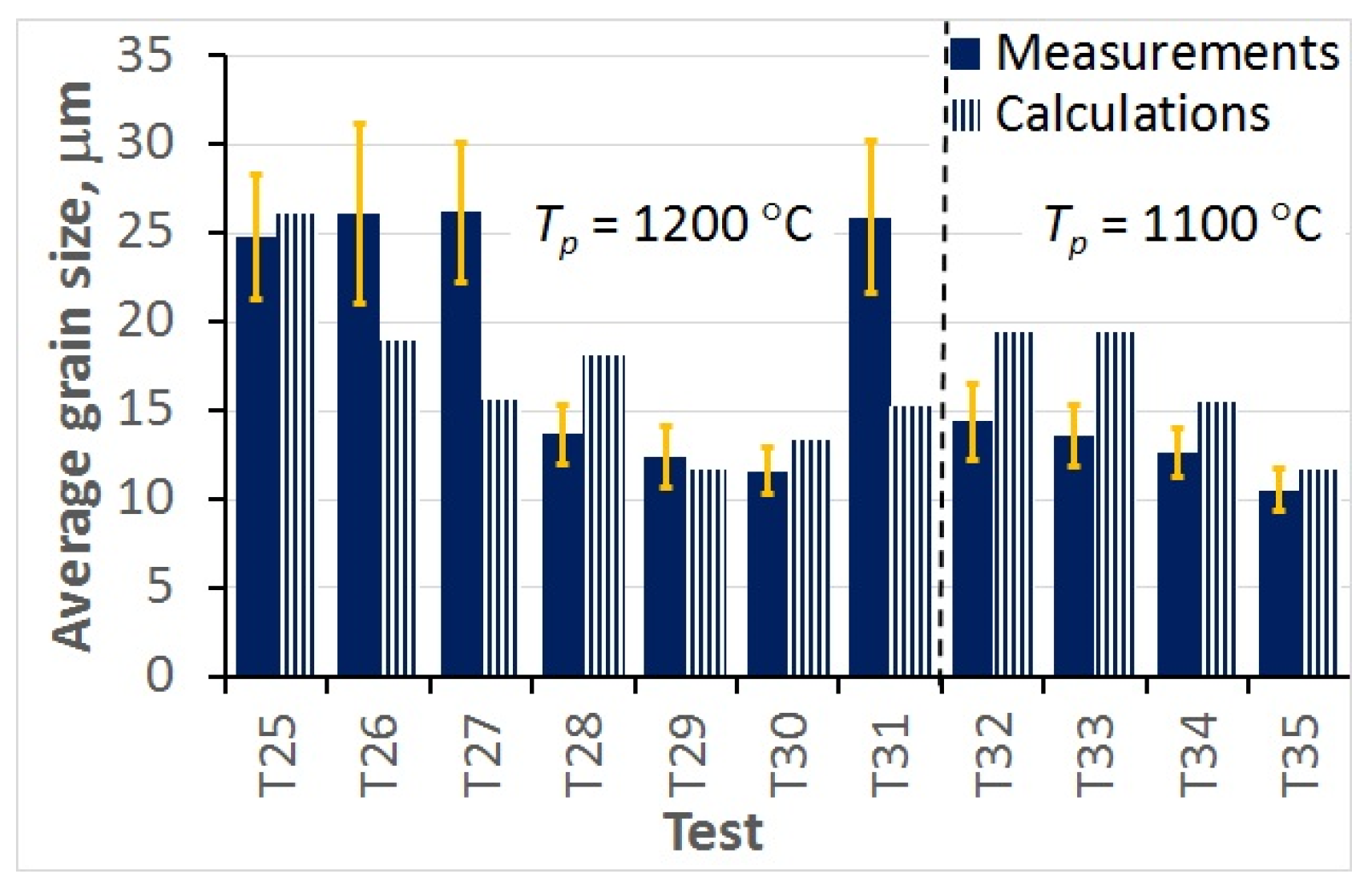

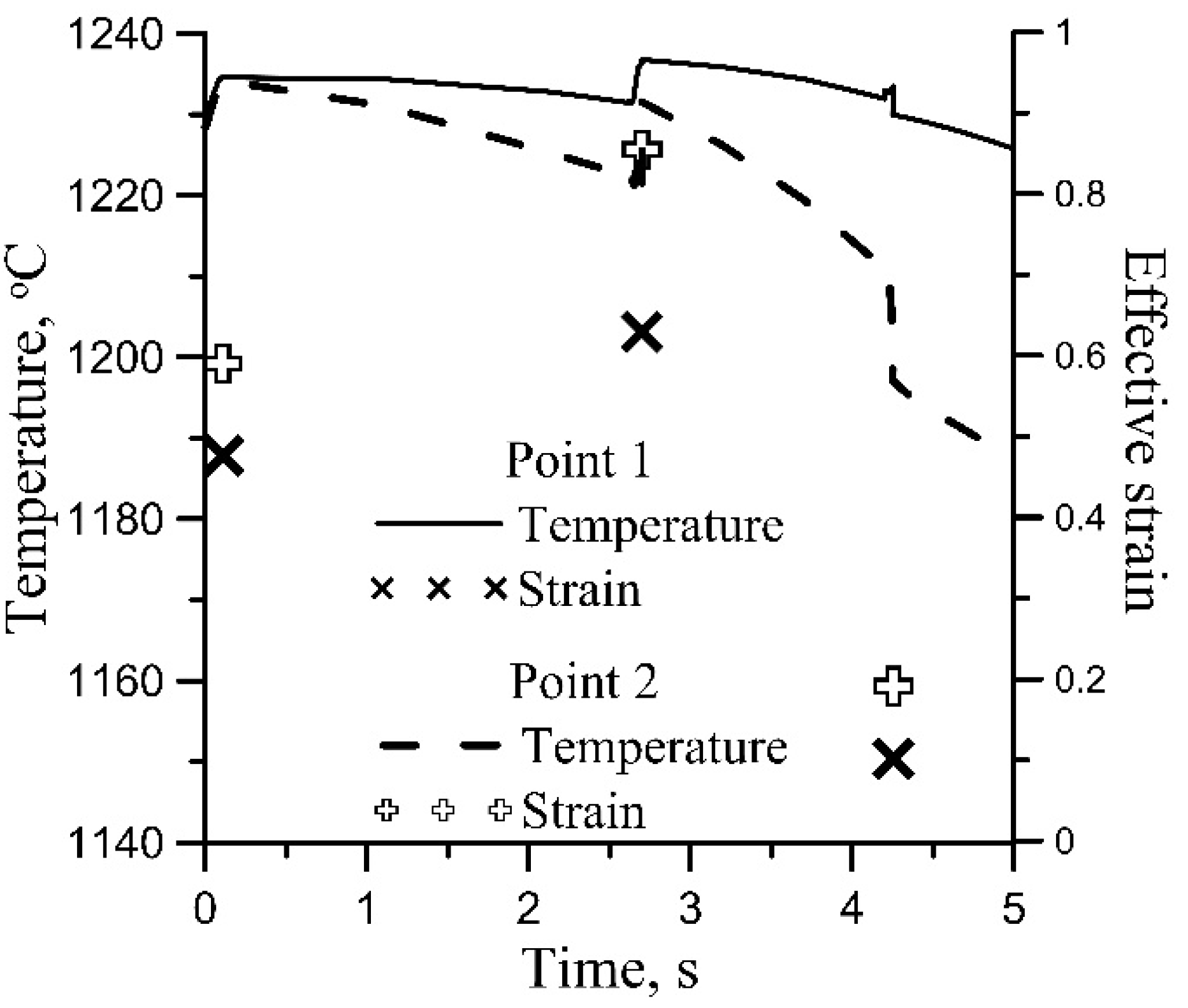
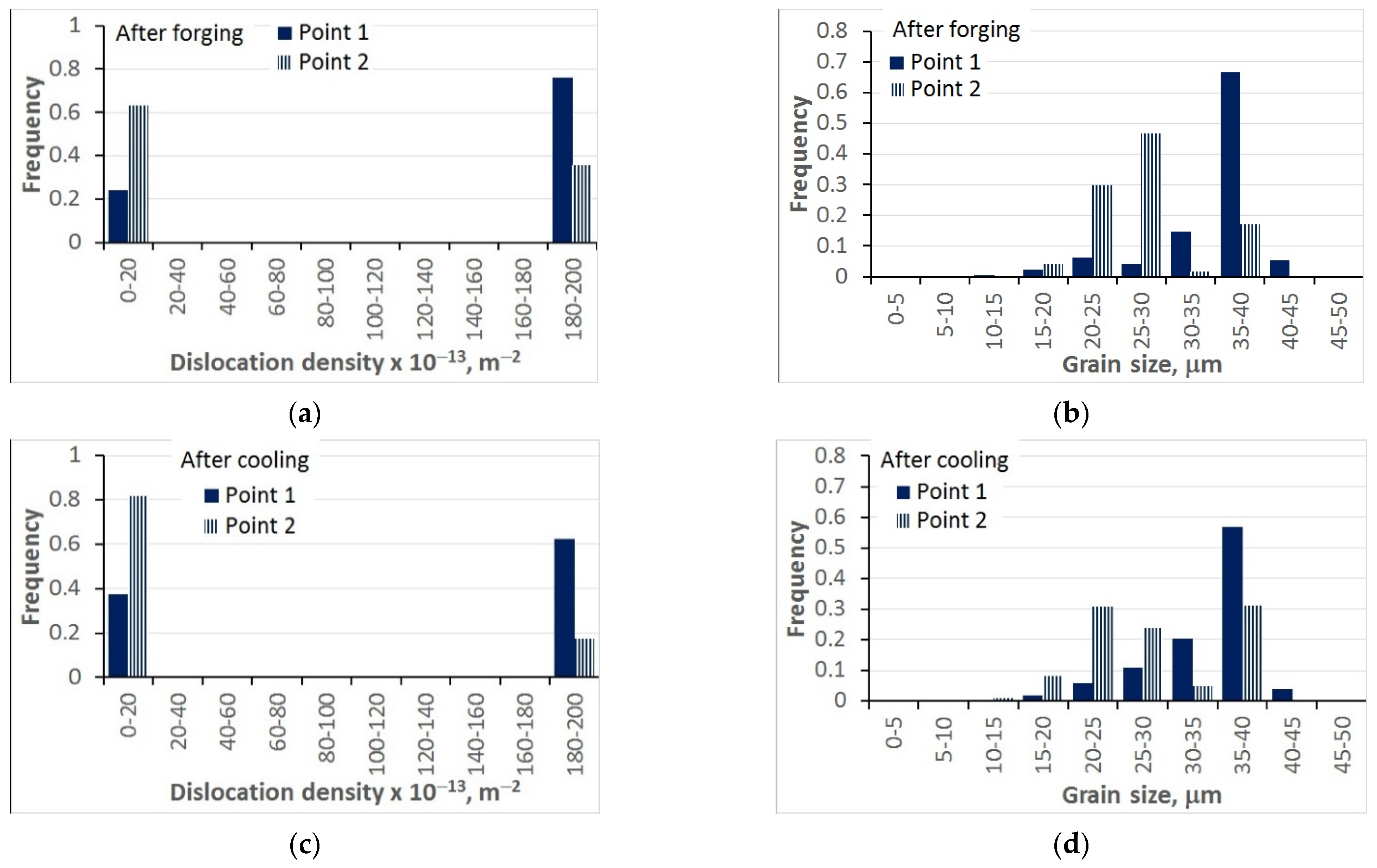
| Hardening | , |
| Recovery |
| Tp = 1200 °C, ε = 1 | Tp = 1100 °C, ε = 1 | ||||
|---|---|---|---|---|---|
| Test | Td, °C | , S−1 | Test | Td, °C | , S−1 |
| T1 | 1200 | 0.1 | T16 | 1100 | 0.1 |
| T2 | 1200 | 1 | T17 | 1100 | 1 |
| T3 | 1200 | 10 | T18 | 1100 | 10 |
| T4 | 1100 | 0.1 | T19 | 1000 | 0.1 |
| T5 | 1100 | 1 | T20 | 1000 | 1 |
| T6 | 1100 | 10 | T21 | 1000 | 10 |
| T7 | 1000 | 0.1 | T22 | 900 | 0.1 |
| T8 | 1000 | 1 | T23 | 900 | 1 |
| T9 | 1000 | 10 | T24 | 900 | 10 |
| T10 | 900 | 0.1 | |||
| T11 | 900 | 1 | |||
| T12 | 900 | 10 | |||
| Tp = 1200 °C | Tp = 1100 °C | ||||||||
|---|---|---|---|---|---|---|---|---|---|
| Test | Td, °C | , S−1 | ε | th, s | Test | Td, °C | , S−1 | ε | th, s |
| T25 | 1000 | 1 | 0.1 | 12 | T32 | 1000 | 1 | 0.2 | 8 |
| T26 | 1000 | 10 | 0.2 | 7 | T33 | 1000 | 10 | 0.2 | 7 |
| T27 | 900 | 1 | 0.2 | 42 | T34 | 900 | 1 | 0.2 | 38 |
| T28 | 1000 | 1 | 0.4 | 1.7 | T35 | 900 | 10 | 0.2 | 17 |
| T29 | 900 | 10 | 0.4 | 8.5 | |||||
| T30 | 900 | 1 | 0.4 | 12 | |||||
| T31 | 900 | 10 | 0.2 | 44 | |||||
| b1 | b2, °C | b3, °C | c1 | c2, °C | c3, °C |
|---|---|---|---|---|---|
| 0.1871 | −12.96 | 132 | 0.9199 | 181.6 | 670 |
| a1 | a2 | a3 | a4 | a5 | a6 | a7 |
| 0.000846 | 302256 | 334,936 | 1.145 | 290,476 | 1.7925 | 0.295 |
| a8 | a9 | a10 | a11 | a12 | a13 | a14 |
| 0.786 | 0.28 | 3,740,945 | 4.3 | 5 × 1021 | 410,000 | 67,484 |
| a15 | a16 | a17 | a18 | a19 | a20 | a21 |
| 0.274 | 20.91 | 0.5 | 45 | 0.29 | 0.19 | 6430 |
Publisher’s Note: MDPI stays neutral with regard to jurisdictional claims in published maps and institutional affiliations. |
© 2022 by the authors. Licensee MDPI, Basel, Switzerland. This article is an open access article distributed under the terms and conditions of the Creative Commons Attribution (CC BY) license (https://creativecommons.org/licenses/by/4.0/).
Share and Cite
Poloczek, Ł.; Kuziak, R.; Pidvysots’kyy, V.; Szeliga, D.; Kusiak, J.; Pietrzyk, M. Physical and Numerical Simulations for Predicting Distribution of Microstructural Features during Thermomechanical Processing of Steels. Materials 2022, 15, 1660. https://doi.org/10.3390/ma15051660
Poloczek Ł, Kuziak R, Pidvysots’kyy V, Szeliga D, Kusiak J, Pietrzyk M. Physical and Numerical Simulations for Predicting Distribution of Microstructural Features during Thermomechanical Processing of Steels. Materials. 2022; 15(5):1660. https://doi.org/10.3390/ma15051660
Chicago/Turabian StylePoloczek, Łukasz, Roman Kuziak, Valeriy Pidvysots’kyy, Danuta Szeliga, Jan Kusiak, and Maciej Pietrzyk. 2022. "Physical and Numerical Simulations for Predicting Distribution of Microstructural Features during Thermomechanical Processing of Steels" Materials 15, no. 5: 1660. https://doi.org/10.3390/ma15051660






